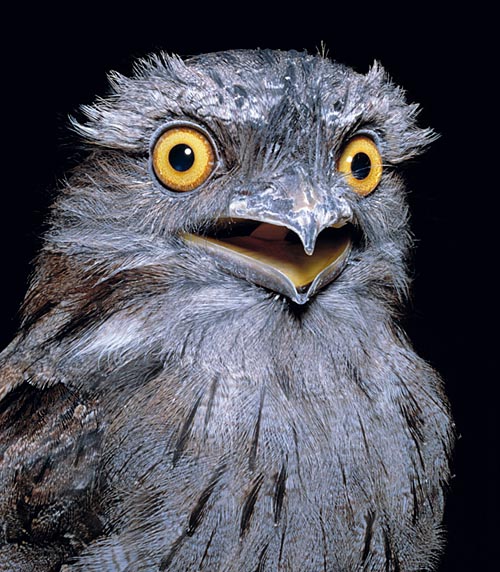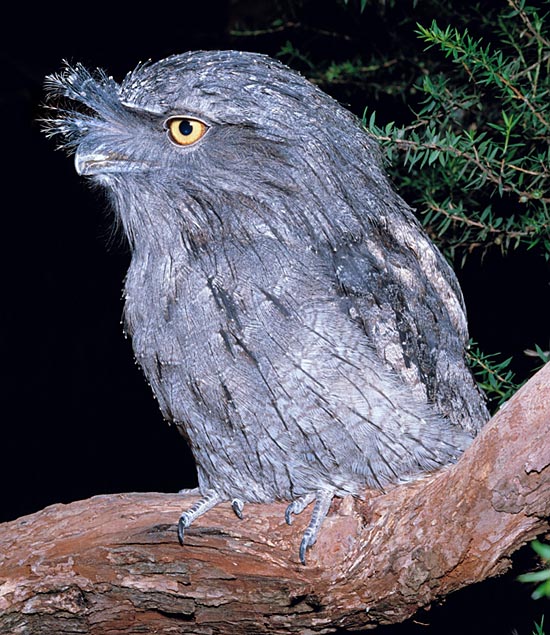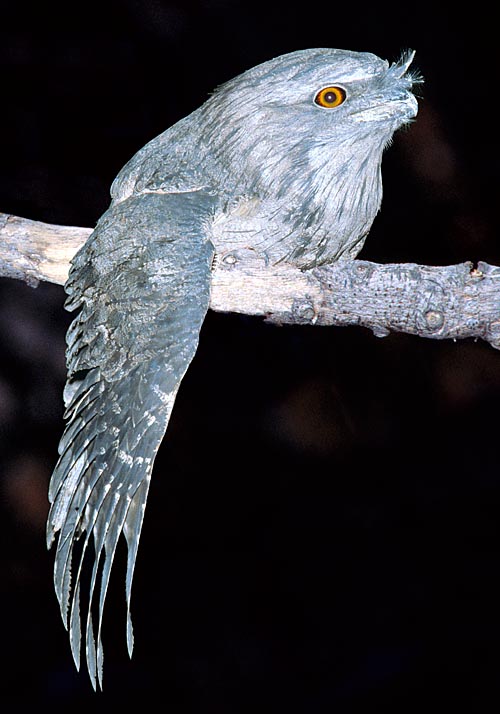Family : Podargidae

Text © Dr Davide Guadagnini

English translation by Mario Beltramini

Podargus strigoides is called frogmouth due the big mouth © Giuseppe Mazza
The Tawny frogmouth (Podargus strigoides Latham 1801) is a strange nocturnal bird with a so much ample mouth to justify its vulgar name of “frogmouth”; it has also big yellow eyes. The particular shape and its typical behavioural attitudes confer this bird a look of an almost fairytale creature. It belongs to the order of the Caprimulgiforms (Caprimulgiformes); to the family of the Podargids (Podargidae), to the genus Podargus and to the species Podargus strigoides.
The species is geographically distributed with some subspecies, differing in size, colouration and shape:
Podargus strigoides strigoides (east of the Australian Great Dividing Range and in Tasmania)
Podargus strigoides phalaenoides (in northern Australia)
Podargus strigoides brachypterus (west of the Australian Great Dividing Range)
The term “podargus”, indicating the genus, comes from the Greek “pous, podόs” and means foot and from “argόs” = idle, lazy and refers to the small legs of the species belonging to this genus; legs which are almost not seen when the birds are perched and that, unlike the raptors, are not used for hunting.
The term indicating the species, “strigoides” comes from the Latin “strix” which means “owl”, and from the Latin “-oides” meaning “shape” and therefore means “similar to the owl” due to the look of this bird which in some way recalls the known nocturnal raptor even if not being, really, strictly akin to this.
Zoogeography
This species is distributed all over the Australian continent, in the coastal islands of Australia, in Tasmania and in southern New Guinea. Its density is greater in the locations where the natural or artificial water is present such as the irrigated areas. It has less dense, sporadic and sparser presence in the zones more arid and without bushes or trees. The species is mainly sedentary.
Ecology-Habitat
The tawny frogmouths live in habitats with cover of trees, in open woods, along the water streams with bushy or tree-lined banks, on hills, mountains and along bushy coasts or with trees. They also live in urban habitats such as golf courses, city parks, gardens and along the planted roadsides. It avoids the desertic habitats having no trees.
Morpho-physiology
The tawny frogmouth has a length of 33-53 cm, a wingspan of 65-98 cm and can reach the weight of 500-700 g (even if captive specimens have reached the weight of 1300-1400 g). All species belonging to the order of the caprimulgiforms have made of the cryptic mimicry their own style of life reaching a level of excellence also in this species.

The small legs, unlike raptors, are of no use in hunting © Giuseppe Mazza
The tawny frogmouth has a mainly grey plumage; strongly and intricately mottled and marbled in pale grey or tawny-brown with dark hues. It has often more brownish-reddish tonalities on the shoulders, the back and on the wings at dorsal level. The colouration is always paler below, but always finely streaked of dark.
In this species do exist great variations of size and colouration; there is also a phase, uncommon, having a rust colour. The cryptic overall look and the livery render it much similar to the bark of the trees on which it stays. On the coast of northern Australia and on the islands, live very small populations presenting a pale-grey or rust-red colouration with some extremely fine drawings and very thin streaks recalling the extremely cryptic liveries of some species of moths.
The eyes have yellow iris and recall quite a lot the typical ones of the nocturnal birds of prey. The beak is ample, as well as the mouth, the prominent portion is robust and hooked. The upper rhamphotheca is surmounted by a tuft of hairs of bristly consistence pointing forward. The maws are yellow-pink.
The legs, grey-brownish, are rather short and weak; they are equipped with 4 fingers, 3 of them being bent forward. The fingers and the nail do not clench strongly and are not utilized for hunting.
The sexes are similar. It lives alone, in pair or in small family groups formed by 3-4 individuals perched on branches, which they imitate thanks to the colouration and the posture, during the day. Sometimes, they perch on the soil camouflaging with the same. If frightened, the get off suddenly and strongly, flying silently and with the wings curved.
This species may be mistaken with other similar species, such as the Papuan frogmouth (Podargus papuensis) when in the grey stage, this one has however red eyes and longer tail. It can be mistaken also with the Marbled frogmouth (Podargus ocellatus) which, however is usually browner and, as the vulgar name states, more marbled. The Podargus ocellatus, has furthermore, greater contrast and difference between the dorsal colouration of the body, darker, and that of the lower parts, paler. Finally, the eyes are yellow-orange (and not pure yellow).
The frogmouths, from the evolutionary point of view, have some similitude in common with the nocturnal birds of prey. Both go hunting during the night utilizing their sharp sight and their very developed hearing. The flight, in the frogmouths as well as in the night birds of prey, is silent and stealthy to snatch the preys without being heard coming suddenly. The eyes, great and bright together with the morbid plumage, therefore emphasize the evolutionary convergence of the frogmouths and of the nocturnal birds of prey. On the contrary, the hunting techniques are different: whilst the nocturnal birds of prey catch the preys utilizing the strong legs equipped with deadly claws, the frogmouths utilize directly the mouth and the beak for seizing the preys.

It has 65-98 cm wingspan and can reach the 700 g © Giuseppe Mazza
Ethology-Reproductive Biology
This species is active at the nightfall. It perches on open branches and on the fences of the enclosures from where it silently takes off hunting flying insects and terrestrial preys and then gets back on the roosts. Therefore, more than actively looking for preys, it waits on the chosen perch for these ones to pass close.
Unluckily, it has the habit of predating insects by hedgehopping to the road; by doing so many birds get run over and killed. It nourishes also of frogs, lizards and other small animals it hunts with nosedives towards the prey.
The frogmouth is a keen hunter thanks to its good eyesight and the excellent hearing. This species emits a sound which is difficult to be precisely localized; it is a low and repeated “oom-oom-oom-omm” (similar to grunts), at times slow, other times rather fast, reverberant and repeated even tens of times; if disturbed, it emits a sound similar to a humming insect.
It is a monogamous species, the pair keeps unite till one of the two members passes away. Usually it reproduces from August to December, that is, during the good season.
The nest is formed by a frail and superficial platform composed by small sticks and small branches covered by leaves; the thickness of the nest is scarce resembling to the nests done by the doves and the pigeons. The nest is usually placed on a horizontal fork of a branch or on a flat base of broken branch at 5-10 metres of height. At times, for the nidification, are used old nests of other species of birds such as the White-winged chough (Corcorax melanorhamphos) or the Australian Magpie (Gymnorhina tibicen).
If disturbed, or if they feel a danger, the hatching birds assume a characteristic position called of “the broken branch”. This posture, incredibly mimetic and that has somehow made famous this bird, makes this bird seem, motionless and with the plumage stuck to the body, like a sort of spur of branch broken at a certain point.
Also during their resting time these birds are difficult to be seen thanks to their strong mimicry; in order not to be remarked, they keep the eyes slit and the beak pointed upward keeping immobile. The beak and the tuft of tactile feathers on the head complete the mimetic work seeming small fragments of bark or shreds of the broken branch they imitate.
The hatching is usually formed by 2 white and roundish eggs. Both parents hatch the eggs for about 25-28 days. The pullets come to life covered by whitish down and have a funny look as the look like a small ball of down where only the eyes and the beak can be distinguished.
The young stay in the nest for about one month; the populations of the southern part of the continent may perform a second annual breeding. They have recently discovered that the frogmouths, during the cold season, are capable to do a sort of hibernation spending most of the days resting, thus reducing the metabolism and lowering the body temperature.
Unlike other species belonging to the same order, the frogmouths can be bred relatively easily in captivity where they willingly accept to nourish of bred insects, house mice, chopped meat, etc. It can live 10 and more years.
→ For general information about Caprimulgiformes please click here
